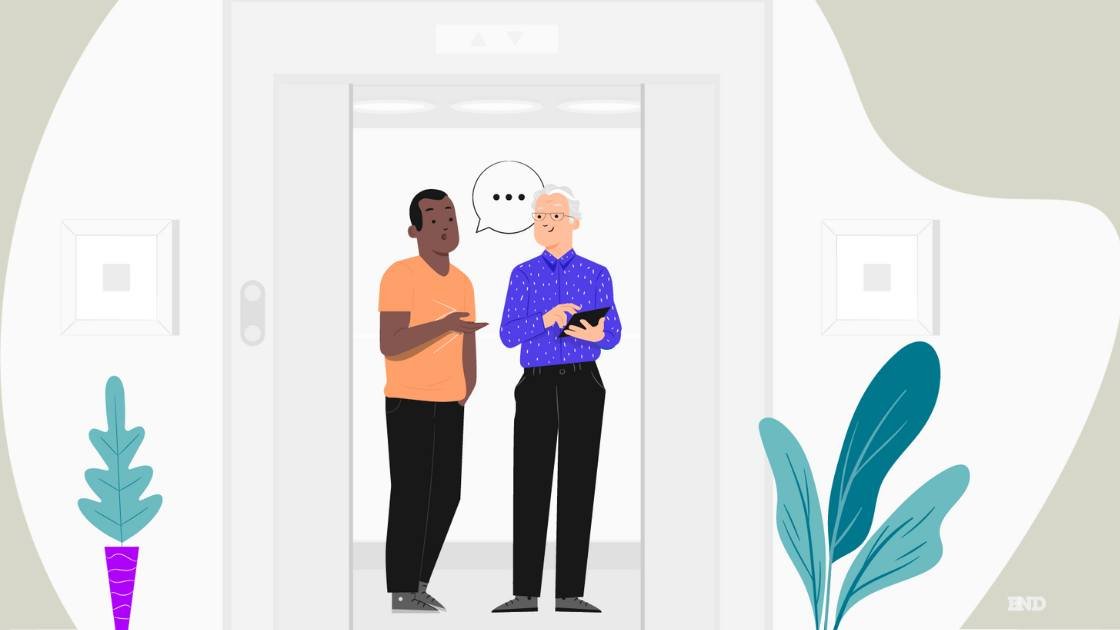Socials
Nothing screams “unprofessionalism” like being asked about what you do and then you start to stutter. This is something you need to fix because, as a freelancer, or a business person, you often find yourself in situations where you have a brief moment to make a lasting impression on potential clients. Crafting the perfect elevator pitch beforehand is the key to success in these situations.
WHAT IS AN ELEVATOR PITCH?
An elevator pitch is a concise and compelling summary of who you are, what you do, and the value you offer. It’s called an “elevator pitch” because it should be so simple and straight to the point that you can deliver it in the time it takes to ride an elevator, typically around 30 seconds to 2 minutes.
By the end of this article, you’ll have Four templates with real-world examples to help you master this essential skill.
Approach Number 1:
The One-Sentence Pitch
This is the simplest, the most common, and possibly the most effective way to draft your elevator pitch. The idea is to condense the long story you might typically have on the “about us” page of your website into one sentence.
Here’s the universal template to help you do this
TEMPLATE: I help “X” achieve “Y” by doing “Z”
X represents your Target Audience
Y represents the Value you offer, and
Z represents how you deliver the value
Here is an example
Example 1:
Hi, my name is Francis, I help Music Artists and Producers achieve their dream of creating hit songs by providing them with my decade of experience as a singer, songwriter, and vocal sample pack creator.
Here’s another one for my alter ego
Example 2:
Hi, I am Francis, and I help Freelancers and Business owners take their business to the next level with insights and coaching on my various channels, sharing my wealth of experience as a Freelancer and entrepreneur myself.
In these two examples created from the template, you know my name, who my services are designed for, what I do for my target audience, and how exactly I deliver this value.
Even if you create your elevator pitch using the other 3 templates I’m about to share with you, you still need to have a
“One-Sentence Pitch” because you may not always have the time to pitch for more than a couple of seconds, and whenever such a situation arises, you will be prepared.
Make sure to memorize your one-sentence pitch, it’s one sentence after all, it’s designed to be memorized, like a slogan or a mantra.
Approach Number 2:
The Problem-Solution Approach
The problem-solving approach focuses on identifying a common pain point your potential client may have and present your services as the ideal solution.
Template: “X” is faced with “Y”, I do “Z” to solve it.
X represents your target audience
Y represents the problem they face
Z represents what you do and how you help them solve it.
Here’s an example
Example:
– Problem: “Many businesses struggle with creating engaging content for their online presence, and in this day and age, great content is king, in fact, if you don’t create great content consistently, your business is almost doomed to fail.”
– Solution: “I provide professional research-based content writing services that captivate your target audience and boost your online visibility. My expertise ensures that your message resonates with the right audience and drives results.”
See how from the beginning of the pitch I went straight into the problem, highlighting how important content is and how businesses are doomed without it, and in the second part, I talk about what I do to solve that problem.
Approach Number 3:
The Success Story Approach
The Success Story Approach leverages real-world examples of how your services have made a positive impact on previous clients.
TEMPLATE: Success Story + Client Benefit
Here’s an example
Example:
– Success Story: “I helped a start-up increase their website traffic by 50% within three months through strategic content creation.”
– Benefit: “I can do the same for your business. My content strategies are proven to deliver results.”
Of course, the story should not be that short with so little detail unless you are pressed for time, I just don’t want this video to be unnecessarily long.
But the idea is to tell a short, possibly verifiable story of your greatest success, highlighting your client’s problem, how maybe they tried other things that failed, and finally how you helped them ultimately fix the problem.
Since this is a story-based template, you have a bit more leeway in terms of time, but then again be conscious not to let your story exceed 2 minutes.
Approach Number 4:
The Unique Selling Proposition (USP) Approach
The USP Approach mainly focuses on what makes your services stand out from the competition.
Template: I have “X” thing that most people don’t have
Where X represents something unique
Here’s an example
Example:
– USP: “Unlike many other songwriters and music producers, I studied music, so I can read and write sheet music, I also learned from my Dad who is also a Musician, from the age of 15 I was already creating music with him, and going on shows and tours around the world when we were not creating. With my experience of the world, I have a unique ability to blend different genres to create truly original music.”
– Benefit: “So with my services, you’ll get music that not only reflects your vision but also stands out in a crowded market.”
That entire story was made up by the way, my father cannot hold a note to save his life, and I don’t know anything about sheet music.
But you get the idea, the story I just made up is easily somebody’s story, and they leave out these unique things that could instantly make their pitch 10x more juicy and interesting to anyone listening.
The trick is to think of your unfair advantages and what you might possess that very few in your industry can boast of having.
Crafting the perfect elevator pitch is a skill that every freelancer and business person should master.
Ideally, you want to have at least two versions, the “one-sentence” pitch and another longer form pitch for when you have more time or someone asks for something more detailed, that’s where The Problem-Solution, Success Story, and Unique Selling Proposition methods and templates come to play.
Your pitch should also be tailored to the specific needs and interests of your audience, and practice it until it flows naturally and doesn’t feel like something you memorized.
Also, it’s absolutely fine if you combine the principles of these different templates to create one killer elevator pitch.
If you like content like this, which covers topics around freelancing, business, personal finance, and productivity, then this is the community for you, consider subscribing to our YouTube Channel and Our Newsletter.





